Firefighters and Armada
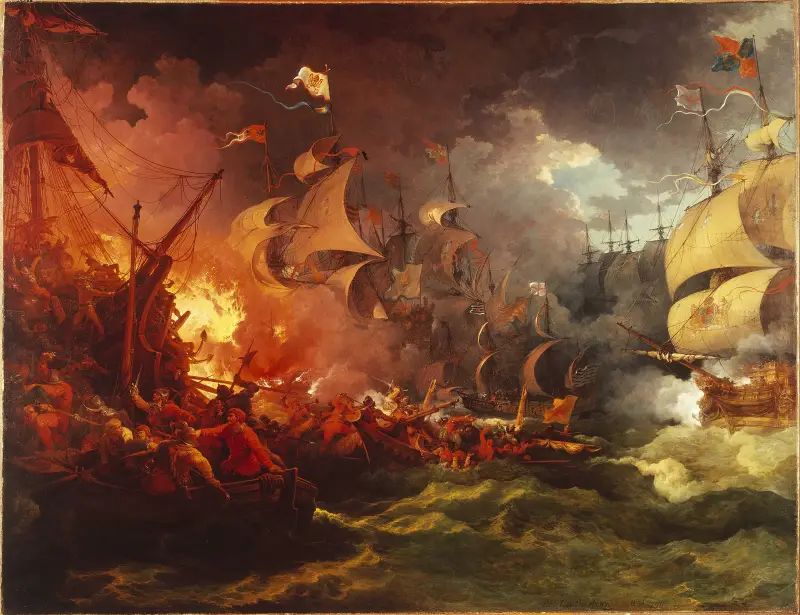
Threatening wooden ships with fire has probably been invented since the beginning of the world. Thucydides also reports that in the war of 415–413 BC. e. The Syracusans attacked 18 Athenian ships with a ship loaded with flammable substances and set it on fire. The Athenians managed to put out the flames, and Syracuse, taking advantage of the confusion, was able to capture several ships.
Arian writes that during the siege of Trier by Alexander the Great, the city’s defenders directed a fire-ship at the siege engines on the ships, and burned some of them. In our article we will not talk about matters so distant, but will talk about the times of the Dutch Revolution, that is, approximately the middle of the XNUMXth century.
Hell's Cars Janibelli
Italian engineer Frederico Gianibelli was born in Mantua sometime in the 1550s. He worked as an architect in Milan, and then decided to offer his services to the Spanish king. For some reason, the new King of Spain, Philip II, refused the services of Janibelli, and he moved to Antwerp, where he began construction and survey work on a private basis.
Everything would be fine, but in 1566 the Dutch uprising began, and pretty soon Janibelli found himself on the other side of the barricades, among the rebels. They say that then the architect personally swore revenge on Philip II, saying that he would regret a hundred times over not hiring him.
This probably turned out to be the loudest revenge against an employer in stories. But first things first.
In July 1584, the Spanish troops of Duke Alessandro Farnese besieged Antwerp, and, in order to block the possibility of supplying the city by sea, began to build a bridge-dam on the Scheldt. By February 25, this anti-ship bridge was built, reinforced with piles driven into the bottom and a stretched iron chain.
To prevent a possible attack on the bridge from land, artillery batteries were placed on the sides, and points for riflemen were erected on the bridge, covered on three sides with wooden walls. A little further downstream, another anti-ship barrier was made, which actually made it impossible for ships to break through to Antwerp.
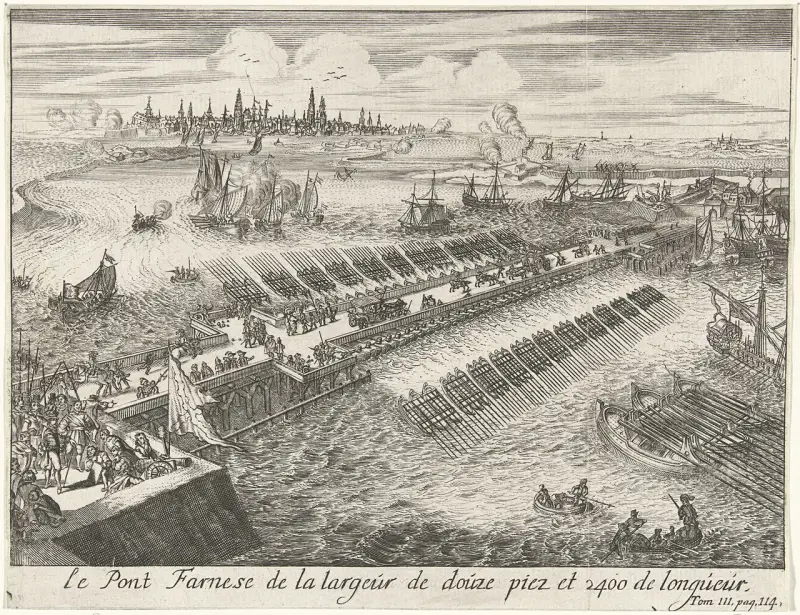
Anti-ship bridge built by the Spaniards during the siege of Antwerp.
Since the depth of the river itself was too great, a movable boom was built between the two spans of the bridge, fastening the boats side to side. Each of these boats was equipped with small cannons that guarded the approach to the bridge. These boats themselves were covered with flooring, and now the bridge was continuous, from shore to shore, and protected from both attack from land and sea.
And here Janibelli came onto the scene, and, according to some sources, he was secretly subsidized by the English Queen Elizabeth I. In general, the Italian engineer proposed to put fire ships on this bridge, making them a “hellish bomb.” First of all, the ships were divided into compartments made of brick. A makeshift brick oven was loaded with 7 pounds (000 tons) of grain gunpowder, and lead tombstones were placed on top, which were covered with broken stones, scrap metal, pottery shards, etc.
Well, then, to make the ship look natural, they covered everything on top with wooden flooring. Janibelli initially proposed the use of three medium-sized merchant ships, Oranje, Post and Gulden Leeuw, but this was refused and only two smaller ships were provided: Fortuyn and Hoop.
At Hoop, the engineer implemented a prototype of a clock mechanism - a natural clock mechanism was connected to a flintlock, which struck a spark after a certain time after the clock mechanism was cocked. According to legend, this mechanism was developed by the Antwerp watchmaker Bory.
To confuse the Spaniards, the Dutch first used 32 conventional fire ships in several waves. Moreover, firewood was piled on top of Fortuyn and Hoop to create the impression that these were ordinary standard fire ships that had already been set on fire and were sailing downwind.
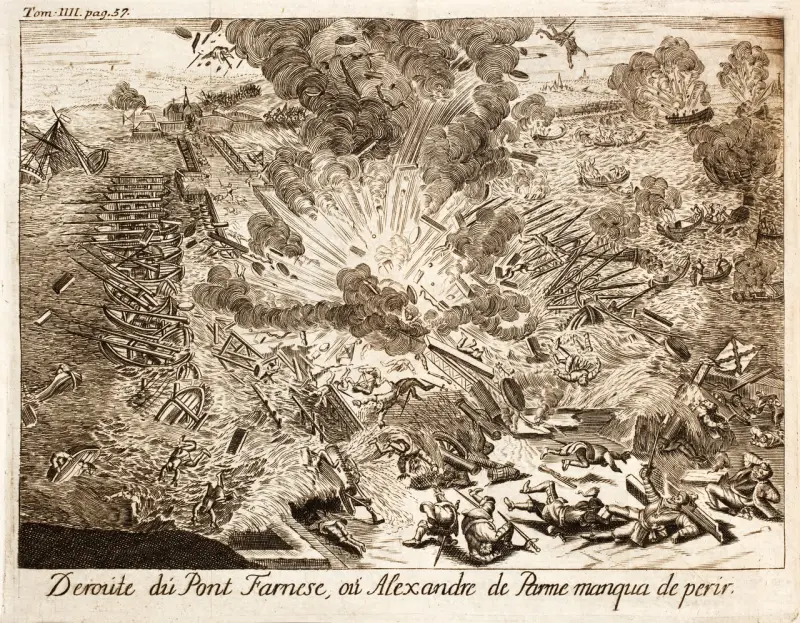
The action of the infernal machine.
The launch took place on the night of April 4–5, 1585. The Spaniards easily caught the first waves of fireships and took them away with ordinary boats. The crew left Fortuyn too early, and it did not have a clock mechanism, so the ship nestled somewhere near the western barriers and exploded (most likely, the charge was placed there incorrectly), without causing harm to anyone.
This is how Lothrop Morley describes it in his History of the Netherlands:
Both ships were carried away by the current from the raft, which, due to a big mistake by the builders, as it later turned out, was made only to protect the floating part of the bridge.
Fortuyn went first, but came across a dam and ended up near Calloo, missing the bridge. There was a moment's pause of anticipation. Finally, slowly, the oil cord on the deck burned out, and there was a small, muffled explosion, causing little or no damage...
Parma's troops, crowded around the stockade and looking out from behind the parapets, greeted this explosion with laughter. They thought it was just child's play to threaten the Spanish army and a general like Alessandro Farnese with pathetic fireworks like this."
But at about 2:30 a.m., I think they changed their minds. The Hoop crew had stronger nerves, they left it later than Fortuyn, and the pilot, leaving the ship, started the clockwork. As a result, Hoop stuck to the junction of the land and floating parts from the side of Fort St. Michael. The Spanish soldiers jumped straight from the bridge to board the fireship in order to capture it and put out the fire, but then there was a gigantic explosion.
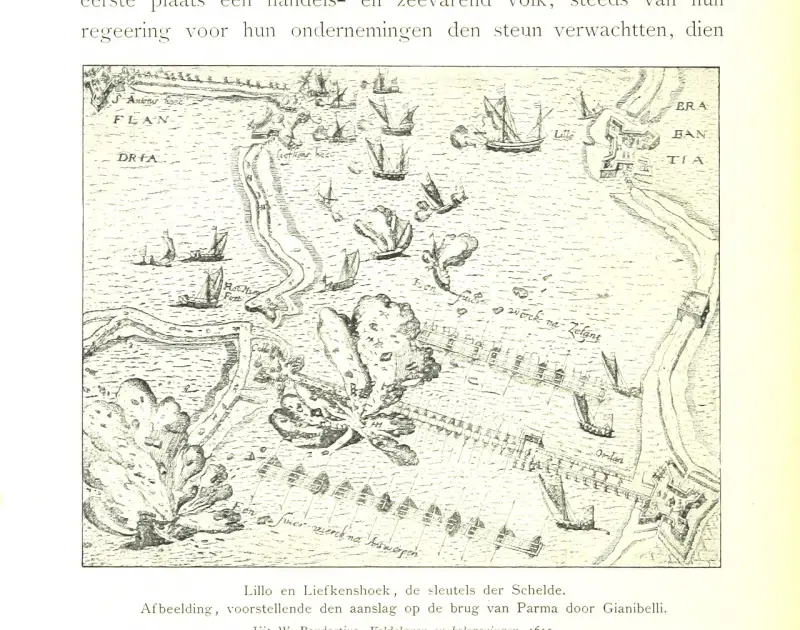
Explosion of Janibelli's infernal machine.
The blast wave demolished part of the bridge, a blockhouse standing near the water, caused a fire on the fastened boats, and also caused a large wave on the Scheldt, which simply washed away the collapsed parts of the bridge and blockhouse.
But that’s not all, because now stones, metal balls or just scrap, clay shards, remains of lead tombstones began to fall from above, maiming and killing people around. To understand the force of the explosion, Captain Richebourg, who was located near the epicenter of the explosion, was found a few days later, his body literally slammed into one of the sunken boats. The Portuguese de Billy simply became one with one of the wooden supports of the bridge.
As for Farnese, who was entering Fort St. Michael at the time of the explosion, the blast wave knocked him down and a wooden chip flew into his shoulder. Messire Alessandro's page took the brunt of the blow, and the blast wave simply carried him off the road and hit the ground.
Spaniards lost up to 1 people (500 killed and 800 wounded).
Thus, Janibelli paid off in full with Philip II, who once refused to take him into service.
Invincible armada
Now fast forward three years to August 8, 1588.
By this time, the invincible Armada had already passed the English Channel like a knife through butter and stood at the Calais roadstead, waiting for Alessandro Farnese's tertiaries to approach it for loading. The English fleet chose long- and medium-range combat as its main tactics, and most of the corsair captains acted in the cruiser paradigm, pursuing the Spanish fleet from behind and attacking damaged or lagging ships.
But such tactics brought the British only three trophies until August 7 - the ships Nuestra Señora del Rosario, San Salvador and Falcón Blanco Mayor. As we understand, the losses are too insignificant for fleet of 137 ships.
And on the night of August 7-8, 1588, Admiral of the Fleet William Winter proposed to the commander of the English fleet, Lord Howard, to attack the Spaniards in the Calais roadstead with fireships. As a result, the ships Talbot, Hope, Thomas, Bond, Bear Yange, Elizabeth, Angel and Cure's Ship were loaded with sulfur, gunpowder, old sails, hemp, tar and other things - and lowered onto the Spanish ships.
Just in the evening the wind changed from southwest to west, plus a powerful tidal current began, which favored the British.
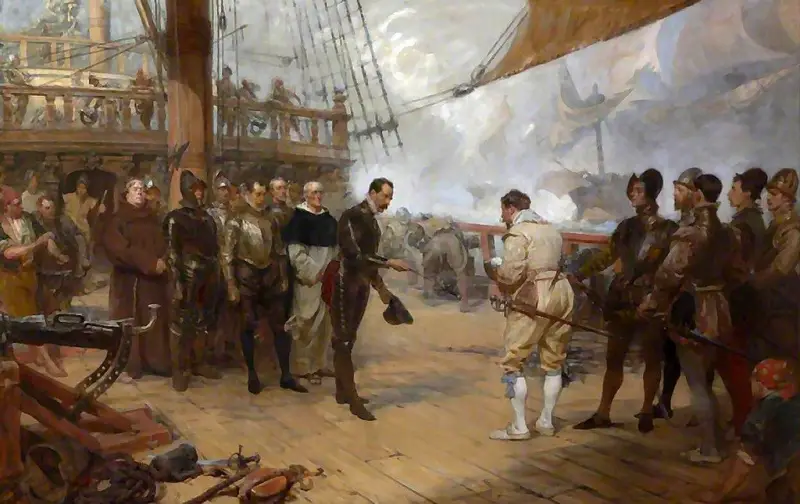
Delivery of the ship Nuestra Señora del Rosario to Drake.
Medina Sidonia placed a barrier of light ships (caravels, patashas, phlibots or zebras) in front of the anchorage to the west of its anchorage, between the Armada and the English fleet. Similar patrol ships were presumably deployed in the east to prevent a surprise attack by the Dutch.
Shortly after midnight, the Spaniards noticed approaching lights heading straight towards them. The alarm was raised, and some of the Spanish teams succumbed to panic.
Why? The answer to the question is the simplest - in Spain it was known that Janibelli had moved to England, and the Spaniards were sure that it was not ordinary fire ships that were sailing, but the infernal machines of the Italian.
As a result, some of the covering ships, in panic, cut off their anchor ropes and began to drift toward the shore. The Spaniards were able to intercept two of the eight fireships, and at that moment Medina Sidonia ordered the Armada to cut the anchor cables, raise the sails and put to sea.

Fireboat attack at Gravelines.
It must be said that the majority of the ships carried out this order not just clearly, but perfectly - only two ships collided with each other. One of these was the galleas San Lorenzo, which lost its rudder during the collision and spent the night trying to row back into Calais. Most of the fleet drifted to the northeast, to Gravelines and the Flemish shoals.
Well, on the morning of August 8, the Battle of Gravelines began, which, although it was not decisive, in it the Spaniards lost two galleons (San Philippe and San Mateo were captured by the Dutch on board), the Navio Trinidad Valencera was intercepted by the British and captured, and the chartered San Pedro Menor simply went over to the enemy's side.
Thus, we can say that the fireboat attack was not completely successful - yes, the enemy was disorganized at first, but by the beginning of the battle he was able to establish relative order and combat effectiveness.
Let us note once again that everything in this situation is to blame for the previous events of 1585. The Spaniards were sure that they were not just ships loaded with flammable substances, but infernal machines. The problem was that in the battles the English fleet used up almost all of its reserves of gunpowder, and it simply did not have gunpowder to equip the infernal machines.
Reincarnation of fire ships at the end of the XNUMXth century
It should be noted that with the introduction of linear tactics in fleets, fireships lost their importance. In a linear battle of squadrons, they could simply either be shot on the approach, or simply passed between the ships. And this scheme worked quite well.
After the Seven Years' War, the French fleet began to develop new tactics, which consisted of fighting at long and medium distances and preventing the British from approaching close combat.
This tactic was tested by the French at the Battle of Ouessan, which, despite its draw, came as a shock to the British. It turns out that the French ships are holding the line just perfectly, the bowsprit of one ship almost lies on the stern of the other, and the British trying to get closer are met with a barrage of fire.
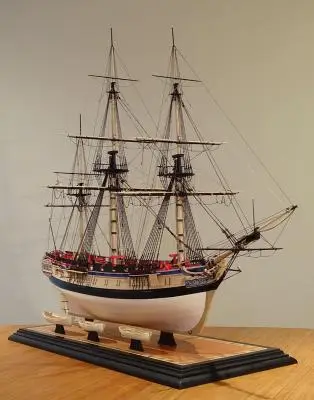
Brander Tisiphone, model.
That is why, in 1779, the English Admiralty remembered the history of the battles with the Armada, and, based on the captured French 20-gun corvette Amazon, decided to begin construction of reinforced fire ships of the Tisiphone class. In fact, this was the project of the destroyer leader's predecessor, or at least the idea was quite similar.
The British reasoned like this: in order to break, violate this French line, it is necessary to carry out a massive attack with fire ships. But if you simply launch ships full of flammable materials at the French, they will simply shoot them with such a dense line on the approach, or take them away in boats. This means that we need to create ships that, being fire ships themselves, can protect unarmed fire ships. Therefore, Tisiphone was armed with as many as fourteen 18-pound carronades and two 6-pound long guns.
Being purpose-built warships, the Tisiphone class had a fire deck instead of an enclosed gun deck, and their guns were located above the fire deck on the main deck, out in the open. The crew was located in the orlopdeck, under the fire deck. The fire deck was divided into small compartments, each of which could be filled with barrels of gunpowder, oil, tar and other flammable substances.
The Tisiphone class ships were essentially giant floating incendiary bombs. When the ship was going to be used as a gunship, the fire deck had to be prepared and the fuse had to be laid and lit at the last minute before the remaining crew left the ship.
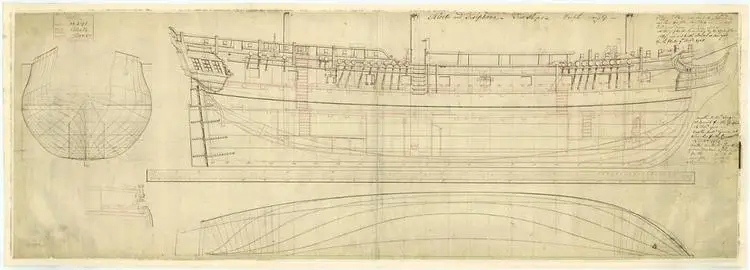
Drawing of Tisiphone, side view.
In normal times, the ship was used as a sloop or messenger ship.
The Tisiphone class fireship had a displacement of 425 tons, a main deck length of 108 feet 9 inches and a beam of 29 feet 8 inches. The crew - 121 people, when used as a fireship - was reduced to 55 people. The cost of construction was £9 195s 3d.
It soon turned out that the idea of attacking a battle line with such fireships was stillborn, but the Tisiphone class ships were simply reclassified as sloops, and they actively fought in both the War of Independence and the Napoleonic Wars.
References:
1. William Laird Clowes, Clements Robert, Sir Markham “The Royal Navy: A History from the Earliest Times to the Present” – Chatham Publishing; Reissue edition, 1997.
2. Ed. Laughton, JK "State papers relating to the defeat of the Spanish Armada, anno 1588", - London, Navy Records Society, 1894.
3. Winfield, Rif "British Warships in the Age of Sail 1714–1792: Design, Construction, Careers and Fates" - Seaforth, 2007.
4. Motley, John Lothrop "History of the United Netherlands", t. 2 – Harper and Brothers, 1900.
5. Lewis, M. “Armada guns” – Austalia, 1961.
Information